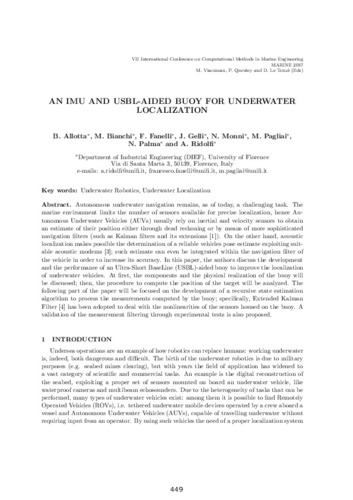An IMU and USBL-aided buoy for underwater localization

Visualitza/Obre
Estadístiques de LA Referencia / Recolecta
Inclou dades d'ús des de 2022
Cita com:
hdl:2117/331882
Tipus de documentText en actes de congrés
Data publicació2017
EditorCIMNE
Condicions d'accésAccés obert
Tots els drets reservats. Aquesta obra està protegida pels drets de propietat intel·lectual i
industrial corresponents. Sense perjudici de les exempcions legals existents, queda prohibida la seva
reproducció, distribució, comunicació pública o transformació sense l'autorització del titular dels drets
Abstract
Autonomous underwater navigation remains, as of today, a challenging task. The
marine environment limits the number of sensors available for precise localization, hence Au-
tonomous Underwater Vehicles (AUVs) usually rely on inertial and velocity sensors to obtain an
estimate of their position either through dead reckoning or by means of more sophisticated
navigation filters (such as Kalman filters and its extensions [1]). On the other hand, acoustic
localization makes possible the determination of a reliable vehicles pose estimate exploiting suit-
able acoustic modems [3]; such estimate can even be integrated within the navigation filter of the
vehicle in order to increase its accuracy. In this paper, the authors discuss the development and
the performance of an Ultra-Short BaseLine (USBL)-aided buoy to improve the localization of
underwater vehicles. At first, the components and the physical realization of the buoy will be
discussed; then, the procedure to compute the position of the target will be analyzed. The
following part of the paper will be focused on the development of a recursive state estimation
algorithm to process the measurements computed by the buoy; specifically, Extended Kalman Filter
[4] has been adopted to deal with the nonlinearities of the sensors housed on the buoy. A
validation of the measurement filtering through experimental tests is also proposed.
CitacióAllotta, B. [et al.]. An IMU and USBL-aided buoy for underwater localization. A: MARINE VII. "MARINE VII : proceedings of the VII International Conference on Computational Methods in Marine Engineering". CIMNE, 2017, p. 449-460. ISBN 978-84-946909-8-3.
ISBN978-84-946909-8-3
| Fitxers | Descripció | Mida | Format | Visualitza |
|---|---|---|---|---|
| Marine-2017-34_An imu and USBL-aided buoy.pdf | 1,392Mb | Visualitza/Obre |

